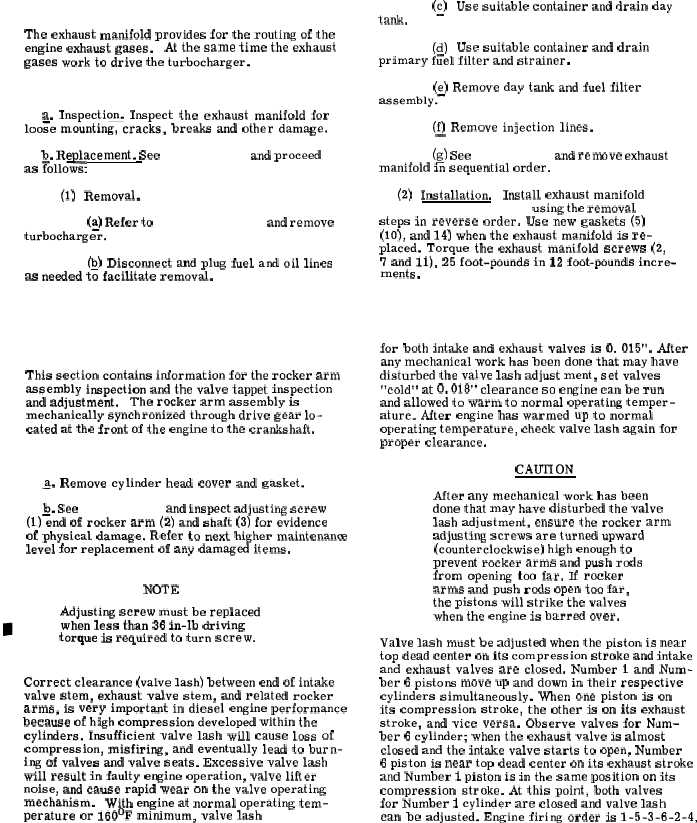S e c t i o n
X L I I .
E X H A U S T
3 - 2 1 6 .
G e n e r a l .
The exhaust manifold provides for the routing of the
engine exhaust gases.
At the same time the exhaust
gases work to drive the turbocharger.
3 - 2 1 7 . I n s p e c t i o n a n d R e p l a c e m e n t .
a. Inspection. Inspect the exhaust manifold for
loo=e mounting, cracks, breaks and other damage.
b. Replacement.
See f i g u r e 3 - 4 7 and proceed
as Follows:
(1)
Removal.
(~) Refer to p a r a g r a p h 3 - 2 0 3 and remove
turbocharger.
&) Disconnect and plug fuel and oil lines
as needed to facilitate removal.
M A N I F O L D
(g)
tank.
(d)
Use suitable container and drain day
Use suitable container and drain
primary fiiel filter and strainer.
(e) Remove day tank and fuel filter
assembly.–
(f) Remove injection lines.
—
(g) See f i g u r e 3 - 4 7 and remove exhaust
manifold in sequential order.
(2)
Installation.
Install exhaust manifold
( 4 , 9 , a n d 1 3 , f i g . 3 - 4 7 ) using the removal
steps in reverse order. Use new gaskets (5)
(10), and 14) when the exhaust manifold is re-
placed. Torque the exhaust manifold screws (2,
7 and 11), 25 foot-pounds in 12 foot-pounds incre-
ments.
S e c t i o n
X L I I I .
R O C K E R
A R M
S H A F T
A S S E M B L Y
3 - 2 1 8 .
G e n e r a l .
This section contains information for the rocker arm
assembly inspection and the valve tappet inspection
and adjustment.
The rocker arm assembly is
mechanically
synchronized through drive gear lo-
cated at the front of the engine to the crankshaft.
3 - 2 1 9 . R o c k e r A r m S h a f t A s s e m b l y I n s p e c t i o n .
& Remove cylinder head cover and gasket.
~. See
f i g u r e
3 - 4 8 and inspect adjusting screw
(1) end of rocker arm (2) and shaft (3) for evidence
of physical damage. Refer to next higher maintenance
level for replacement of any damaged items.
NOTE
Adjusting screw must be replaced
when less than 36 in-lb driving
torque is required to turn screw.
3 - 2 2 0 . V a l v e T a p p e t C l e a r a n c e A d j u s t m e n t .
Correct clearance (valve lash) between end of intake
valve stem, exhaust valve stem, and related rocker
arms, is very important in diesel engine performance
because of high compression developed within the
cylinders. Insufficient valve lash will cause 10SS of
compression, misfiring, and eventually lead to burn-
ing of valves and valve seats. Excessive valve lash
will result in faulty engine operation, valve lifter
noise, and cause rapid wear on the valve operating
mechanism.
With engine at normal operating tem-
perature or 160°F minimum, valve lash
for both intake and exhaust valves is O. 015”. After
any mechanical work has been done that may have
disturbed the valve lash adjust ment, set valves
“cold” at 0.018” clearance so engine can be run
and allowed to warm to normal operating temper-
ature. After engine has warmed up to normal
operating temperature, check valve lash again for
proper clearance.
CAUTION
After any mechanical work has been
done that may have disturbed the valve
lash adjustment, ensure the rocker arm
adjusting screws are turned upward
(counterclockwise)
high enough to
prevent rocker arms and push rcxds
from opening too far. If rocker
arms and push rods open too far,
the pistons will strike the valves
when the engine is barred over.
Valve lash must be adjusted when the piston is near
top dead center on its compression stroke and intake
and exhaust valves are closed. Number 1 and Num-
ber 6 pistons move up and down in their respective
cylinders simultaneously. When one piston is on
its compression stroke, the other is on its exhaust
stroke, and vice versa. Observe valves for Num-
ber 6 cylinder; when the exhaust valve is almost
closed and the intake valve starts to open, Number
6 piston is near top dead center on its exhaust stroke
and Number 1 piston is in the same position on its
compression stroke. At this point, both valves
for Number 1 cylinder are closed and valve lash
can be adjusted. Engine firing order is 1-5-3-6-2-4,
3 - 1 1 0
C h a n g e 1

